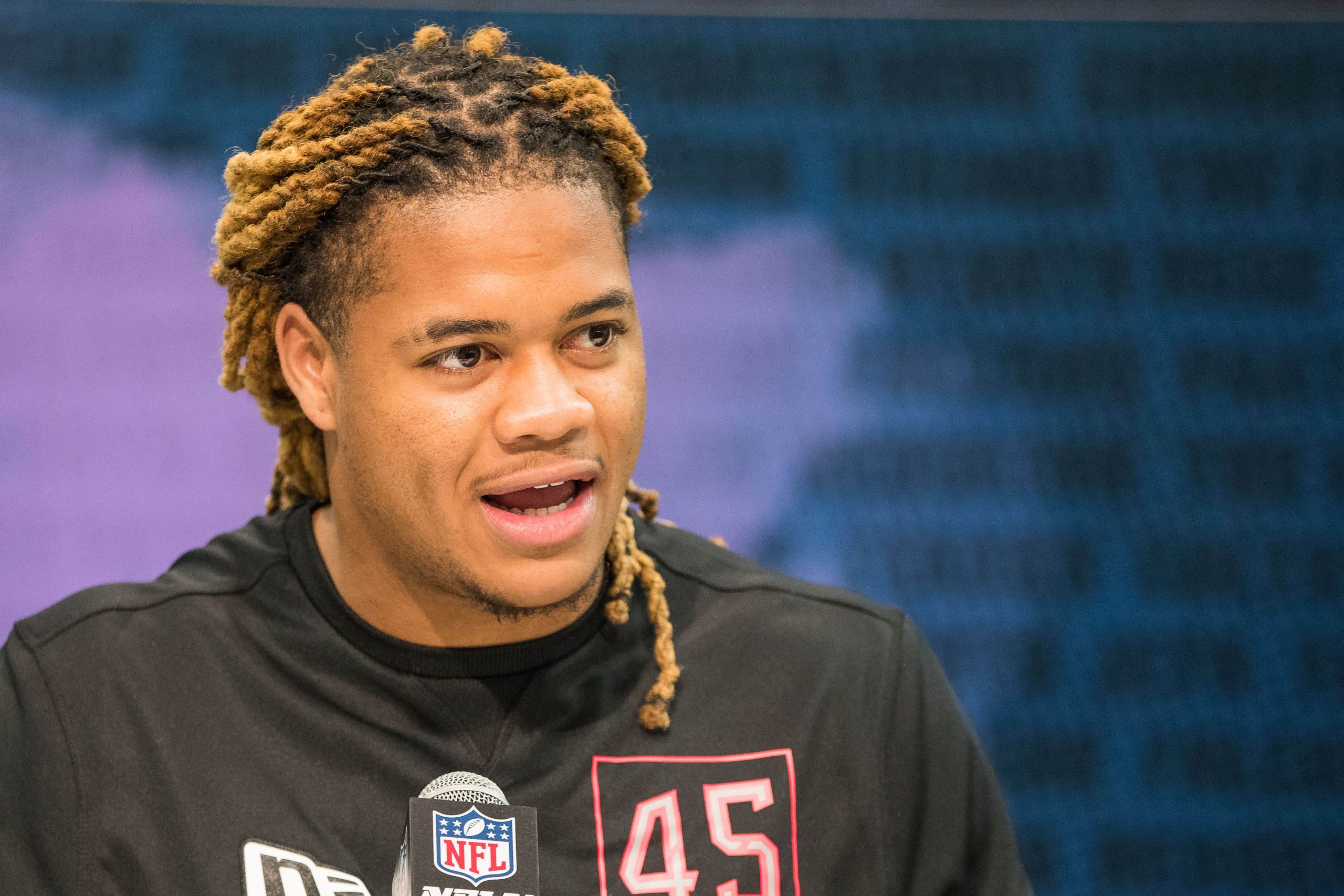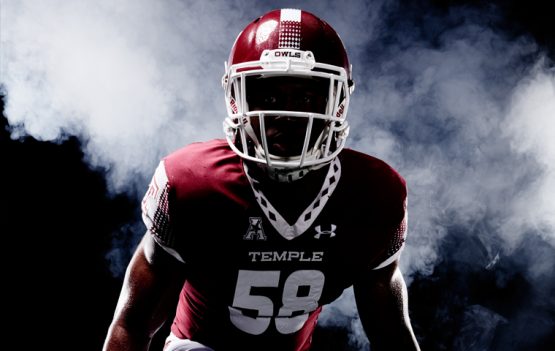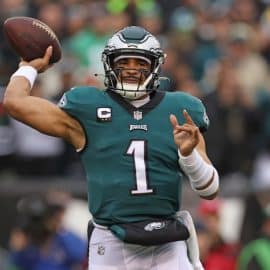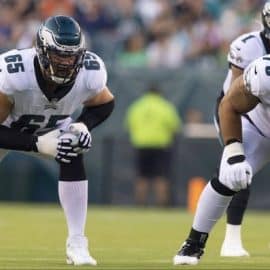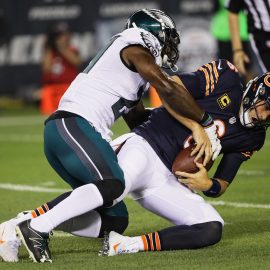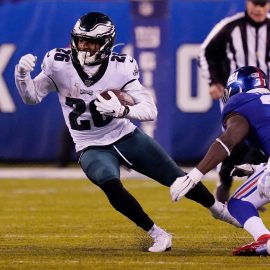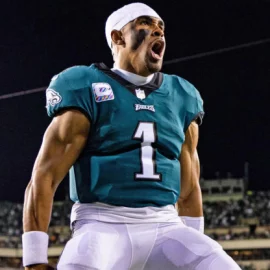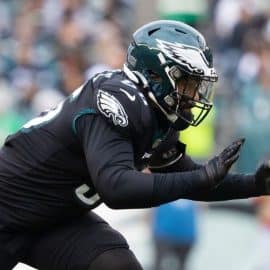In 2019 the Eagles got a 2nd-round gem when they drafted Miles Sanders. It’s one reason to pay attention to the Running Backs drill results from Friday’s scouting combine action. Why not look for a complementary back in later rounds if one of these guys performed well in the drills, tested well otherwise, and just happened to be available when it was your turn to hand in the ticket?
Here’s how Fran Duffy of PE.com had the RB’s rated going into the Combine drills on Friday:
Top of the heap: D’Andre Swift, Georgia
The Philadelphia native is a dynamic playmaker who can stay on the field for all three downs and be a threat as both a runner and as a pass catcher. He stands out with his ability to make the first man miss. He’s the running back most likely to be selected in the first round of this year’s draft.
Workout warrior: J.K. Dobbins, Ohio State
Watching Dobbins, I can’t help but think of Eagles running back Miles Sanders, who was one of the top performers at last year’s Combine. Dobbins is an explosive, quick-twitch athlete who should shine during the athletic tests.
Off the radar: LeVante Bellamy, Western Michigan
There’s not a lot of buzz surrounding Bellamy at this point, but the explosive back from the MAC will have a lot more attention after the Combine. Don’t be surprised if he makes a run at breaking the 4.40-second mark in the 40-yard dash.
Stopwatch shocker: Jonathan Taylor, Wisconsin
Most people think of the bruising Badgers back as a tough, between-the-tackles runner, but he’s an explosive track athlete who was the two-time state champ in the 100-meter dash in high school. He’s going to shock people with how he tests this week.
Will kill the drills: Clyde Edwards-Helaire, LSU
Lateral agility? Check. Pass catching? Check. Vision? Check. Toughness? Check. Edwards-Helaire checks a LOT of boxes. He’ll put his complete skill set on display in Indianapolis. Expect him to test better than people think in the athletic portion of the workout as well.
Trust the tape: Eno Benjamin, Arizona State
Benjamin isn’t the most explosive athlete, but he has excellent contact balance and body control. Like Kareem Hunt back in 2017, Benjamin may not test off the charts, but he’s able to create yards on his own. He was productive over the last couple of seasons for Herm Edwards in the desert.
Most productive college player: AJ Dillon, Boston College
No back in this class has been more productive than Taylor, who reached 5,000 career rushing yards faster than any back in FBS history, but Dillon has put up plenty of numbers as well. The Connecticut native was the first back to rush for over 1,000 yards in each of his first two seasons on campus, and he added a third for good measure this past year, allowing him to be named first-team All-ACC three times.
One-year wonder: Deejay Dallas, Miami
Perhaps the best blocker in the class at the position, Dallas stepped in this season as a starter and averaged 6 yards a carry for the Hurricanes. The junior brings speed and the ability to impact along the perimeter. He is also a rock-solid option on third down as both a catcher and pass protector.
Best pro comparison: Darius Anderson, TCU
I nearly placed Anderson as my Workout Warrior because he’s an excellent athlete. He reminded me a lot of former Fordham running back Chase Edmonds, with his frame and ability to catch passes out of the backfield. When healthy, Edmonds has made plays over the last two seasons for the Arizona Cardinals.
Best story: Cam Akers, Florida State
It’s worth noting anytime a player is the top recruit at his position coming out of high school. Akers was that guy three years ago even though he was both a quarterback and a running back. His career with the Seminoles did not quite go as planned. Sure, he broke Dalvin Cook’s record for rushing yards as a freshman in 2017, but he never quite lived up to his billing due to the supporting cast around him. Akers’ story will be an interesting one to follow through this process as well as the early stages of his NFL career.
Small-school standout: Benny LeMay, Charlotte
At just over 5-8 and 220 pounds, LeMay is built for the NFL and can win in multiple ways. He can make people miss with power, wiggle, and vision. Not to mention, he can catch passes out of the backfield. LeMay figures to carve out a nice role in an NFL backfield.
Philly connection: Josh Kelley, UCLA
Swift is a Philadelphia native and Taylor grew up right across the bridge in South Jersey, so there are some local connections here, but don’t forget about Kelley. Not only did he play for a former Eagles coach with the Bruins in Chip Kelly, but he also grew up idolizing Rocky Balboa. In fact, he believes he’d be a great fit to play the character on the silver screen.
Most to prove: Zack Moss, Utah
Moss is an excellent talent and a bruiser between the tackles with deceptive athleticism to make people miss in the hole. He’s one of the best backs in the class on film, but knee injuries have plagued him over the last couple of years. His medical check will be huge for him this week.
So how did these guys perform on Friday? Here are Daniel Jeremiah’s winners and losers:
Winners
1. A.J. Dillon, Boston College
Dillon is the largest back of the class at 247 pounds, 15 pounds heavier than any other prospect at the position. That didn’t stop him from finishing with some of the best marks Friday.
His 41-inch vertical jump was best among running backs, as was his 131-inch broad jump. Even his 4.53-second 40-yard dash was in the top 10.
2. Jonathan Taylor, Wisconsin
It’s a tight race to be the first running back off the board in April. Winning the 40-yard dash race will help Taylor’s case.
His unofficial time of 4.41 seconds was the fastest of all running backs in the class. It got even better when the official time came in at 4.39 seconds.
3. Cam Akers, Florida State
Dan Kadar said no player needed to perform well at the NFL Combine more than Akers. The Swiss cheese offensive line at Florida State made life difficult for the running back, so Friday was a chance for Akers to show that he has the skills to shine in a better situation.
Akers seized the opportunity. His 4.47-second 40-yard dash proved he has plenty of speed and he was even more impressive when it came time for positional drills.
4. Darrynton Evans, Appalachian State
Taylor was the only running back who beat Evans’ time of 4.41 seconds. It was Evans who got the upper hand over Taylor in the vertical jump, broad jump, and bench press, though.
Evans isn’t the most well-known running back prospect, but he was among the top performers in almost every category Friday. He doesn’t seem to mind flying under the radar, however.
Losers
1. Javon Leake, Maryland
Leake was a big-play back for the Terrapins. On only 145 career rushing attempts, he averaged 7.9 yards per carry and had 17 rushing touchdowns. Over and over, Leake would see a seam and zip through it for a huge gain.
So it’s a little baffling that he ran the 40-yard dash in 4.65 seconds, making him one of the slowest running backs in the draft class.
His 34-inch vertical jump was in the bottom half at the position too. Ultimately, game speed is much more important than NFL Combine speed. But Friday raised serious questions about Leake’s capability of running away from players in the pro ranks like he did at Maryland.
2. Zack Moss, Utah
Every player has several opportunities to work out for NFL scouts and decision makers before the draft. If a player isn’t 100 percent, it really doesn’t make sense for them to try to perform.
Evidently, nobody told Moss that. Despite suffering a hamstring injury, the Utah running back kept participating in drills Friday.
The result was an unsurprisingly poor showing. His 4.65-second 40-yard dash (tied with Leake) was near the bottom of the class. Moss is more of a bruising back anyway, so subpar speed was never going to tank his stock. But he would’ve been better off sitting out the drills altogether if his hamstring wasn’t feeling right.
Add The Sports Daily to your Google News Feed!
